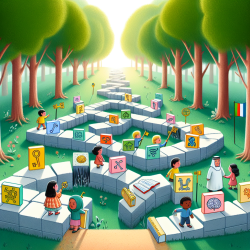Introduction
In the dynamic field of speech-language pathology, understanding task difficulty is crucial for creating effective interventions. A recent study titled "Towards a common code for difficulty: Navigating a narrow gap is like memorizing an extra digit" offers insightful data that can enhance our approach to therapy, particularly in educational settings. This blog explores how the findings from this research can be applied to improve outcomes for children receiving online therapy services.
The Essence of Task Difficulty
The study by Feghhi, Franchak, and Rosenbaum (2021) investigates the concept of task difficulty by comparing physical and cognitive challenges. It posits that task difficulty may be represented by a single, abstract quantity, akin to memorizing an additional digit when navigating a narrow gap. This innovative approach provides a new perspective on how we can assess and address challenges faced by children in therapy.
Applying Research to Practice
For practitioners at TinyEYE, integrating these findings into therapy sessions can lead to more tailored and effective interventions. Here are some ways to implement the research outcomes:
- Personalized Task Design: Use the concept of task equivalence to create personalized therapy tasks that balance physical and cognitive demands, ensuring they are neither too easy nor too difficult for each child.
- Assessment and Adjustment: Regularly assess the difficulty level of tasks and adjust them based on the child's progress, using the study's findings as a guide for measuring task equivalence.
- Multi-Modal Learning: Encourage a multi-modal approach to learning by integrating physical activities with cognitive tasks, similar to the study's methodology, to enhance engagement and retention.
Encouraging Further Research
While the study provides a foundational understanding of task difficulty, further research is encouraged to explore its implications in diverse educational settings. Practitioners are urged to contribute to this growing body of knowledge by conducting their own studies and sharing findings with the community.
Conclusion
The insights from "Towards a common code for difficulty" offer a promising avenue for enhancing speech-language pathology practices. By understanding and applying these principles, we can better support children's development and create more effective therapeutic outcomes. To delve deeper into the original research, please follow this link: Towards a common code for difficulty: Navigating a narrow gap is like memorizing an extra digit.










